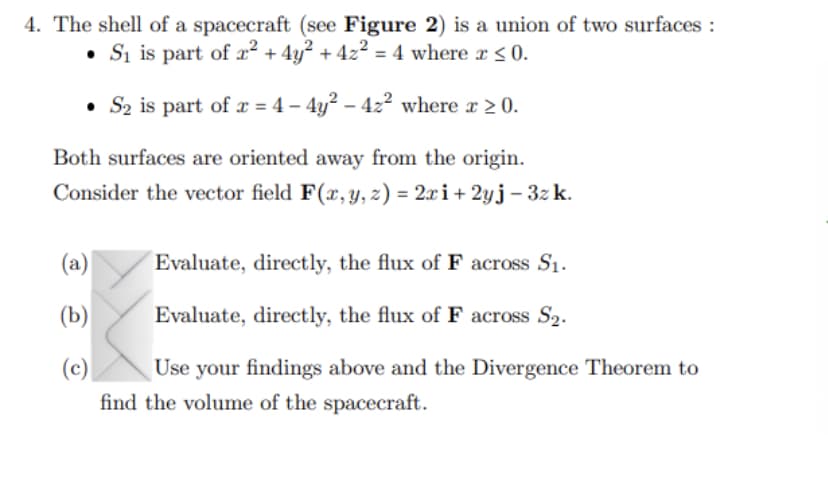4. The shell of a spacecraft (see Figure 2) is a union of two surfaces : • S₁ is part of 2² + 4y² + 4z² = 4 where a ≤ 0. • S₂ is part of x=4-4y² - 42² where a 20. Both surfaces are oriented away from the origin. Consider the vector field F(x, y, z)=2xi + 2yj-3zk. (a) Evaluate, directly, the flux of F across S₁. (b) Evaluate, directly, the flux of F across S₂. (c) Use your findings above and the Divergence Theorem to find the volume of the spacecraft.
4. The shell of a spacecraft (see Figure 2) is a union of two surfaces : • S₁ is part of 2² + 4y² + 4z² = 4 where a ≤ 0. • S₂ is part of x=4-4y² - 42² where a 20. Both surfaces are oriented away from the origin. Consider the vector field F(x, y, z)=2xi + 2yj-3zk. (a) Evaluate, directly, the flux of F across S₁. (b) Evaluate, directly, the flux of F across S₂. (c) Use your findings above and the Divergence Theorem to find the volume of the spacecraft.
Algebra and Trigonometry (MindTap Course List)
4th Edition
ISBN:9781305071742
Author:James Stewart, Lothar Redlin, Saleem Watson
Publisher:James Stewart, Lothar Redlin, Saleem Watson
Chapter9: Vectors In Two And Three Dimensions
Section9.FOM: Focus On Modeling: Vectors Fields
Problem 11P
Related questions
Question

Transcribed Image Text:4. The shell of a spacecraft (see Figure 2) is a union of two surfaces :
• S₁ is part of 2² + 4y² + 4z² = 4 where x ≤ 0.
• S₂ is part of x = 4 - 4y² - 42² where x ≥ 0.
Both surfaces are oriented away from the origin.
Consider the vector field F(x, y, z) = 2xi + 2yj - 3zk.
(a)
Evaluate, directly, the flux of F across S₁.
(b)
Evaluate, directly, the flux of F across S₂.
(c)
Use your findings above and the Divergence Theorem to
find the volume of the spacecraft.
Expert Solution
This question has been solved!
Explore an expertly crafted, step-by-step solution for a thorough understanding of key concepts.
Step by step
Solved in 4 steps with 4 images

Recommended textbooks for you

Algebra and Trigonometry (MindTap Course List)
Algebra
ISBN:
9781305071742
Author:
James Stewart, Lothar Redlin, Saleem Watson
Publisher:
Cengage Learning

Algebra and Trigonometry (MindTap Course List)
Algebra
ISBN:
9781305071742
Author:
James Stewart, Lothar Redlin, Saleem Watson
Publisher:
Cengage Learning